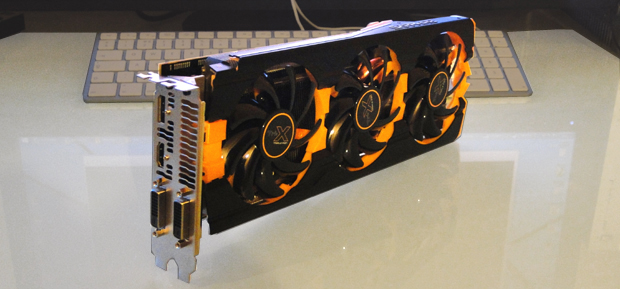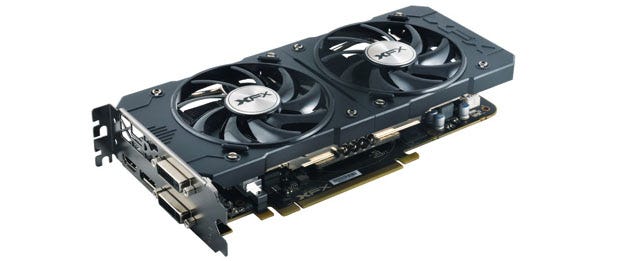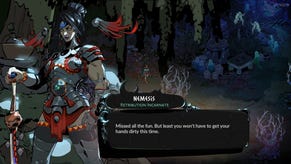AMD's Radeon R9 380X Graphics And 'Crimson' Driver
Old as new is getting old
Rejoice, for among we mere mortals walks a new AMD graphics card. But hang on. Is it actually new? If it isn't, what is going on with PC graphics these days and why do we keep having to make do with these thinly disguised rebadges? The answer is simple and the solution, happily, is imminent. Meanwhile, AMD has a new graphics driver out, and by that I mean not just a driver update but a whole new interface and platform. Give it up for AMD Crimson and kiss goodbye to that awful Catalyst interface.
Take the jump for an overview of the new AMD Radeon R9 380X and Crimson and a hint of why 2016 is shaping up to be the most exciting year in PC graphics since the early days of hardware T&L...
The new(ish) AMD Radeon R9 380X
So, the new AMD Radeon R9 380X. What, exactly, is it? In simple terms it's an AMD Tonga graphics chip, 'Tonga' being one of those internal codenames the online rumourati love to bandy about.
Tonga is not a new chip. It first appeared a little over a year ago in the then-new Radeon R9 285. Of course, you could argue even Tonga was just a rehash of the Tahiti chip that first appeared in the Radeon HD 7970, shortly after cyanobacteria evolved the ability to photosythesise carbon dioxide and water into sugars. Early 2012, I think it was.
Admittedly, Tonga sports the '1.2' version of AMD's prevailing GCN or 'Graphics Core Next' graphics architecture where Tahiti is merely GCN 1.0. But we are not talking about dramatic differences. In reality, Tonga exists to do the same job as Tahiti but more cheaply, thanks to its less complex 256-bit memory bus. Except it actually has more transistors, which normally makes for a more expensive chip. Confusing? Hang with me.
 A Radeon R9 285. Which isn't anything like the new 380X. Not one little bit
A Radeon R9 285. Which isn't anything like the new 380X. Not one little bit
Of course, we've already seen the Tonga chip rebranded. What was the Radeon R9 285 became the Radeon R9 380 with virtually no changes at all. In both cases you got 1,792 of AMD's GCN 1.2 shaders for doing all those fancy graphical effects, 112 texture units for processing, er, textures and 32 ROPs or render outputs for spitting out the end result. OK, the 380 was clocked up from 918MHz to 970MHz, but little of consequence had changed.
The saving grace for this 'new' Radeon R9 380X chipset is that it's what you might call Tonga fully unleashed for the first time in a desktop graphics card. That's because the Tonga chip itself has always had 2,048 shaders and 128 textures, it's just AMD hadn't previously enabled them all. That's what made previous Tonga implementations cheaper. The odd broken shader or texture unit didn't matter due to the built-in redundancy.
What does this all mean in the real world? Well, it's a bit faster than a 380. But the 380X along with the 380, the 285 and indeed the 280X and 7970 before them all deliver a similar subjective gaming experience. They'll generally beast any game running at 1,920 by 1,080 pixels, otherwise known as 1080p.
Ramp things up to 2,560 by 1,440 pixels or 1440p with the details set to full reheat and it will then be a matter of what game you are running. Something arcadey like GRID Autosport will return frame rates in the high 50s and be very playable. Something more demanding like BattleField or GTA V will be mid 30s or maybe even high 20s and so marginal at full graphical detail.
 The Nvidia GeForce GTX 960: The new 380X's nemesis?
The Nvidia GeForce GTX 960: The new 380X's nemesis?
As for the Nvidia comparison, most of the time the new 380X is a fair bit quicker than a GeForce GTX 960 but also a lot slower than a GTX 970. In the end it all comes down to price and with the 380X coming in around £185 / $229 it's inevitably positioned between those two Nvidia chipsets. You pays your money. You takes your choice.
Graphics in 2016
It's certainly a nice board for the money. The catch is that there's a revolution coming in 2016 and anything bought in the next, say, three to six months could find itself rapidly outdated in a more dramatic fashion than has been the norm of late.
That's because pretty much all GPUs have been made using 28 namometer silicon since way back in late 2011. But now, finally, that's going to change. Both AMD and Nvidia are reportedly gearing up to unload new graphics chips built on much more advanced silicon. This won't be an incremental die-shrink thanks to slightly smaller transistors, but a really big jump that incorporates fancy stuff like FinFET technology, truly monumental transistor counts up near 20 billion and perhaps the promise of true 4K-capable performance. Genuinely, it is all very exciting.
 Here's an AMD 290. Which then turned into a 390 18 months later...
Here's an AMD 290. Which then turned into a 390 18 months later...
I don't want to get too bogged down in the details here as I'll wrap that all up in some end-of-year coverage that's all about why 2016 is looking like a corker for the PC generally and not just for graphics. But it certainly seems like the 380X is the last in a long line of what have often felt like stopgap graphics card. And a good thing that is, too.
AMD's 'Crimson' driver
But what of Crimson, AMD's new graphics driver? Well, say goodbye to AMD Catalyst. Say hello to simply Radeon Settings. That's the name for the new interface and from the initial installation dialogue through the to the final UI it's all much cleaner, much more modern. It also makes 'discovery' of features a lot easier. I've been playing around with AMD's Advanced Super Resolution purely because its existence was so much easier to stumble upon in the new interface. I think it's actually been in the driver since late last year.
 AMD's new Crimson driver isn't just a pretty face. Well, that's my story and I'm sticking to it
AMD's new Crimson driver isn't just a pretty face. Well, that's my story and I'm sticking to it
The panel for the individual game profiles and optimisations is particularly sweet, too – it's the sort of improvement that I think will actually encourage AMD users to get the most out of their cards, which can only be a good thing.
Having said that, clicking 'Additional Settings' in some parts of the interface kicks you back into the old 'Catalyst' style menus for some of the more advanced settings. That looks and feels clunky and does rather beg the question of whether the changes are more than skin deep. It's redolent of Windows 10's patchy mix of old and new and not in a good way. Sorry, but even if all the important code is actually ancient, I don't want to be reminded!
 Even the install process looks cleaner and simpler
Even the install process looks cleaner and simpler
As for performance, well, AMD has released a long list of tweaks with the new driver platform. That includes general game performance and specific features like its LiquidVR tech that's designed to optimise AMD graphics for virtual reality rendering, one key feature of which is reducing latency, which is critical for VR. There are also improvement for FreeSync, 2D video decode, Eyefinity multidisplay and more.
On the subject of quality control, AMD says it has ramped up testing to include more PC configurations than ever in order to reduce the bug count. Of course, it turned out the first Crimson release had a bug in the fan control software that actually killed some cards, which is so typically AMD you couldn't make it up. But there's now a beta version available that fixes the problem.
 'Discoverability' of new features is much improved...
'Discoverability' of new features is much improved...
In practice, it seems like the new driver is only adding a few percentage points to game performance but overall I'm feeling pretty upbeat about the changes, even if 20 seconds of black screen during install did give me some harrowing flashbacks of earlier AMD driver installs that have completely broken my OS. It even seems to have fixed my multi-display HDCP problems in Amazon Prime Video.
As you leaf through the reams of changes and upgrades, it's hard not to marvel and what has become something of an OS within an OS. The levels of complexity are borderline alarming these days. But at the very least this new AMD effort is a lot nicer to use and look at. If you have an AMD card and haven't tried it, it's worth a quick spin.
 But some throwbacks from the Catalyst era remain
But some throwbacks from the Catalyst era remain








